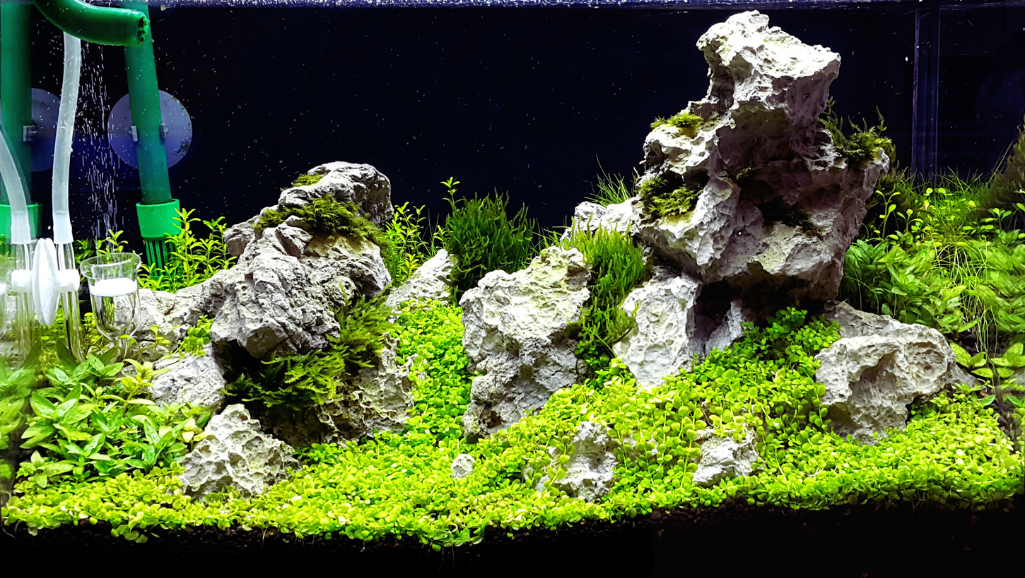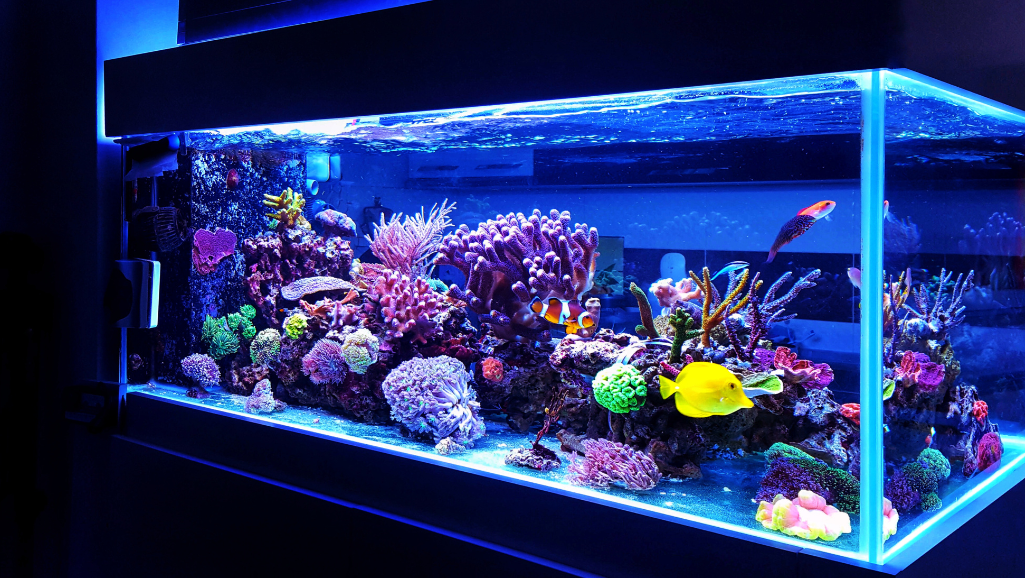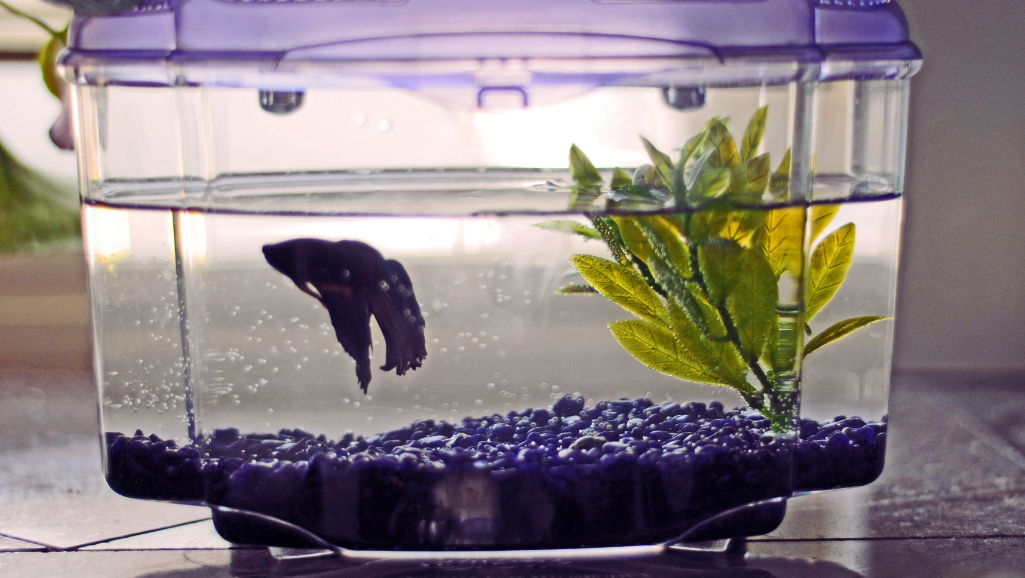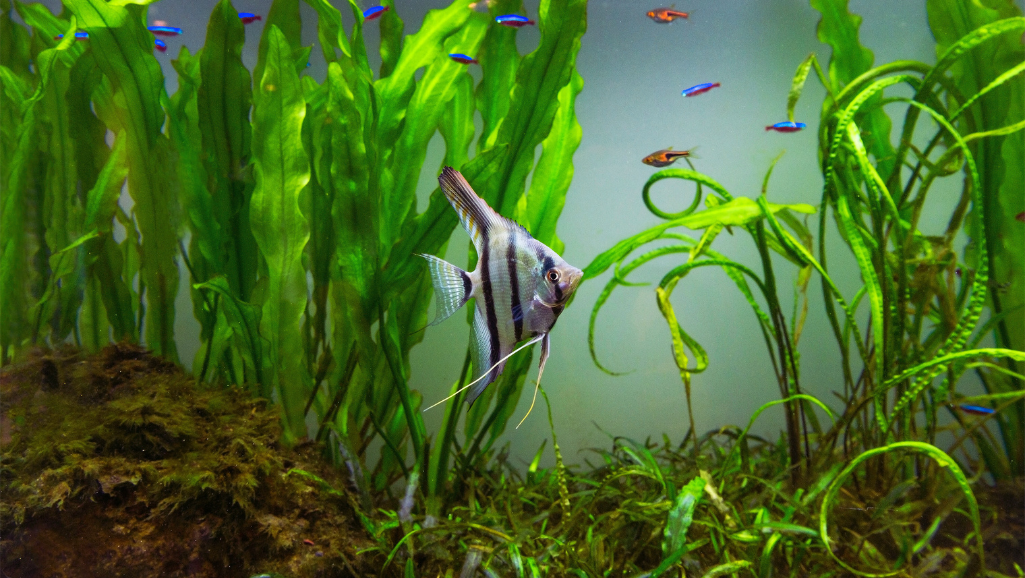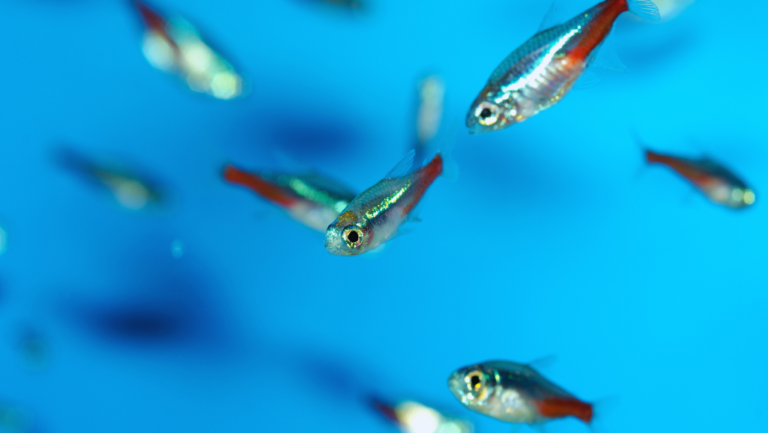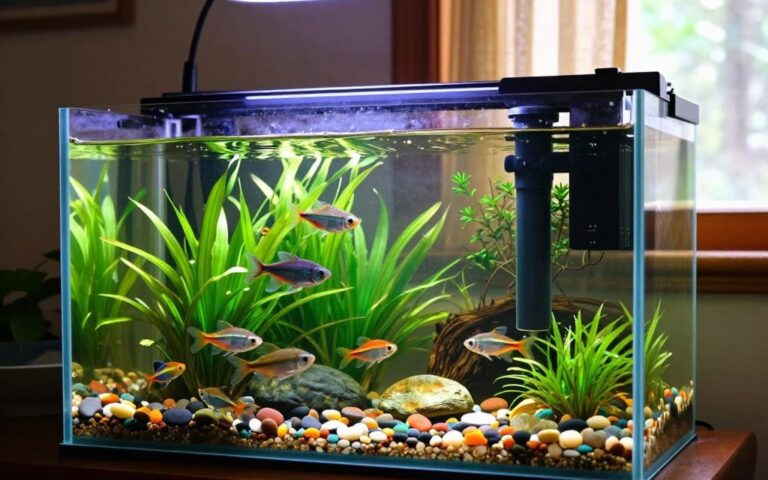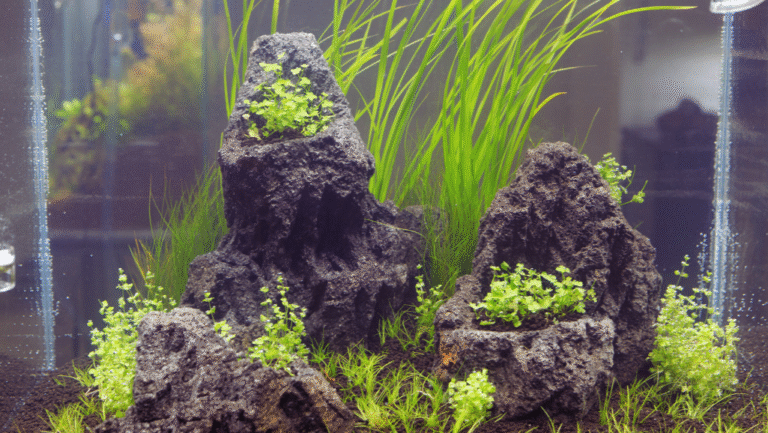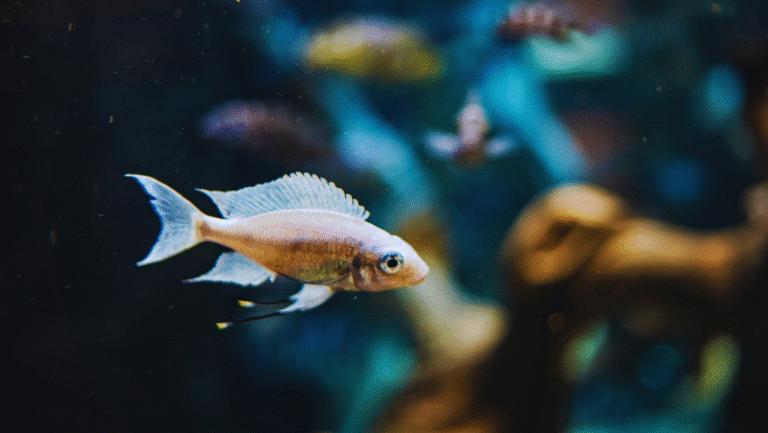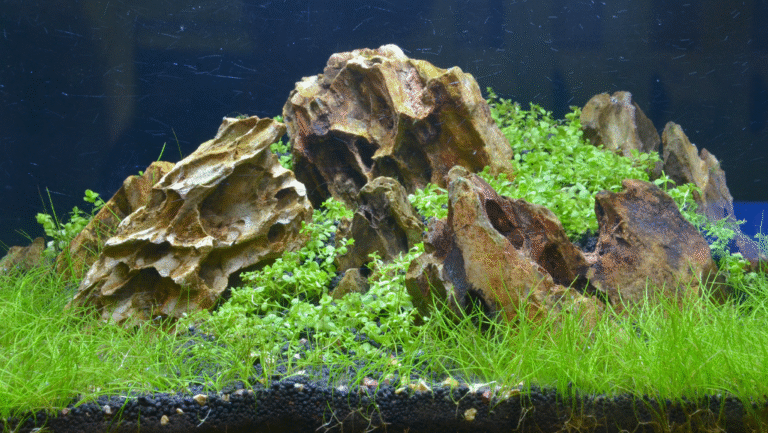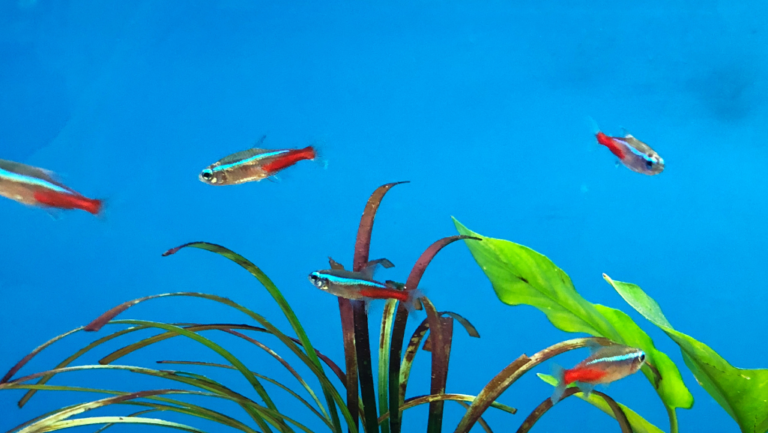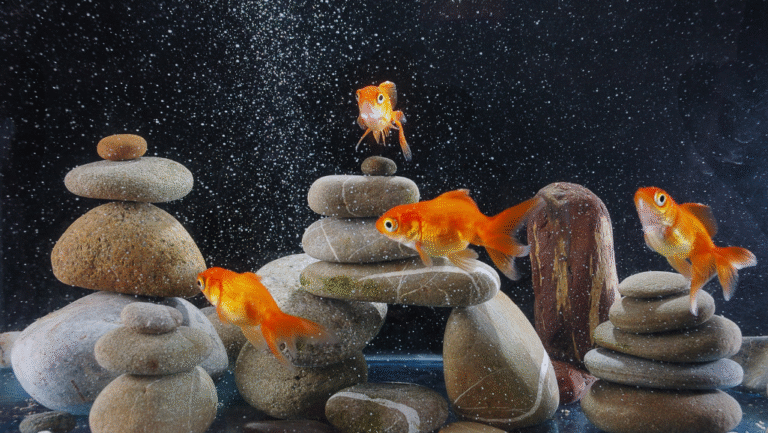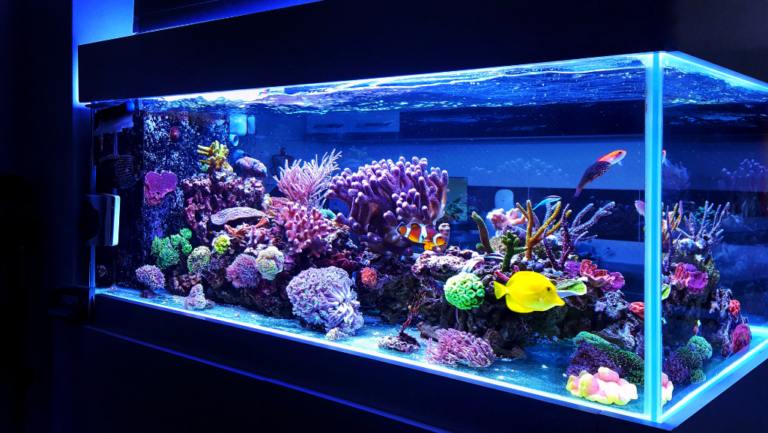If you’re starting with aquariums, new tank syndrome is a hidden danger. It can harm your fish quickly, with a timeline from two to twelve weeks. This shows how crucial the aquarium nitrogen cycle is. It needs time, patience, and careful watching to avoid and treat.
Without attention, your fish might act strangely. They might swim slowly or lose their appetite. This could mean your tank is in trouble.
Building a strong biological filter takes time, from four to six weeks. New aquarium owners can fall into the trap of new tank syndrome. But, with the right knowledge and actions, you can keep your tank healthy.
By following good aquarium care practices, you can create a safe home for your fish.
If your fish are showing signs of illness, you must act fast. Water changes and tests are key. Adding fish slowly is also important. This helps your tank stay balanced.
Knowing how to handle ammonia is crucial. It can harm your fish’s breathing. But, with careful management, your tank can be peaceful and healthy. Learn more about treating and preventing new tank syndrome with regular care and checks.
Key Takeaways
- how fast will new tank syndrome kill a fish.
- Biological filtration is crucial to protect fish from new tank syndrome, taking up to six weeks to mature.
- Monitoring for signs of stress can prevent losses—regular water testing is vital for early detection.
- Gradual fish introduction allows for the stabilization of the ecosystem and reduces the risk of new tank syndrome.
- Understanding the steps of the aquarium nitrogen cycle is essential for maintaining a healthy tank.
- Immediate action and fish-less cycling methods are recommended to manage and prepare for the onset of toxic spikes in new aquariums.
- Ammonia levels should always be heeded, with levels above 0ppm considered perilous for aquatic life.
Understanding New Tank Syndrome and Its Impact on Aquatic Life
Understanding new tank syndrome is key for aquarium beginners. It’s when a new tank struggles to create a stable filter. This is crucial for keeping water healthy. During this time, ammonia levels can rise, harming fish.
Definition of New Tank Syndrome
New tank syndrome hits new aquariums hard. It can also affect older tanks if they lose good bacteria. Without these bacteria, ammonia and nitrite levels get too high, harming fish. Keeping water parameters in check from the start can avoid this problem.
Common Symptoms in Fish Due to New Tank Syndrome
- Decreased appetite and lethargy
- Cloudiness of tank water
- Increased slime production
Seeing these signs means it’s time to check and fix the water. It shows how important good bacteria are in keeping the water safe.
The Duration Required for Biological Filtration to Mature
Starting a biological cycle in a tank takes time, usually four to six weeks. This is when good bacteria start to grow and make the tank stable. Being patient is important, as rushing can harm the fish.
To help during this time, you can add bacteria from other tanks. But be careful not to bring in bad bacteria. Regular water tests and careful changes can help your tank thrive.
The Critical Role of the Aquarium Nitrogen Cycle
Creating a healthy fish tank starts with the fish tank cycling process. This process is key for keeping the tank balanced. It supports both plants and animals.
The cycling process grows beneficial bacteria in fish tanks. These bacteria turn harmful waste into safer forms. This is crucial to avoid new tank syndrome, which can harm fish.
Breaking Down the Stages of the Nitrogen Cycle
When you first set up a tank, ammonia levels can rise. This is because of fish waste and uneaten food. Luckily, the fish tank cycling process introduces beneficial bacteria. They change ammonia into nitrite, which is less harmful but still dangerous in high amounts.
- It’s important to check nitrite levels regularly. Use tools like the sera NO2-Test to keep them below 0.5 mg/l.
- During the 5th to 15th day of a new tank, these bacteria are key in keeping the environment stable.
- If nitrite levels spike, use sera Nitrite-minus to lower them. This helps keep the tank safe for fish.
How Beneficial Bacteria Convert Toxic Waste into Safer Products
The last step of the nitrogen cycle is when beneficial bacteria in the fish tank turn nitrite into nitrate. Nitrates are much less harmful. They can be managed through regular water changes and plant absorption.
To avoid new tank syndrome, use products like Fast Filter Start. They help beneficial bacteria grow faster. Also, keep water parameters stable by testing them often. This can prevent big problems.
Managing the aquarium nitrogen cycle well keeps fish safe and supports all aquatic life. This balance is achieved through monitoring, regular care, and understanding the tank’s biology. It shows how important beneficial bacteria in the fish tank are.
How Fast Will New Tank Syndrome Kill a Fish
New Tank Syndrome can quickly harm fish, making it crucial to treating ammonia in fish tank settings fast. Larger fish are more at risk. The buildup of ammonia and nitrite needs quick action. Knowing how beneficial bacteria help in the tank is key.
Ammonia, from fish waste, is a big threat. It harms gills and makes it hard for fish to breathe. This can cause ammonia poisoning in fish tank settings, showing signs like fast gill movements and distress.
- Watch water levels closely, looking for spikes in ammonia or nitrite.
- Do 50% water changes right away if you see sudden increases.
- Add mature filter media from other tanks to speed up beneficial bacteria growth.
- Keep good aeration and don’t overfeed to reduce waste.
Using mature biological filtration media can help fight New Tank Syndrome. It gives time for a healthy bacterial colony to grow. Learning about setting up a fish tank is key to preventing problems.
Being patient and testing water often is crucial when treating ammonia in fish tanks. Spotting ammonia poisoning signs early can save lives.
Stabilizing chemical levels in new tanks takes weeks. This shows how important it is to watch and act early. Every day counts, making constant vigilance and quick action essential for fish care.
Preventing Fish Tank Ammonia Spikes: Tips and Methods
Keeping your fish tank healthy means avoiding ammonia spikes. These spikes can happen if you overfeed, don’t have enough filtration, or add too many fish at once. Knowing how to manage your tank’s water is key to keeping your fish safe.
To avoid ammonia spikes, you need a good plan for your tank. Here are some tips and methods to help:
- Introduce Fish Gradually: Adding too many fish at once can cause waste and ammonia. Start with a few hardy fish and add more slowly.
- Monitor Water Parameters Regularly: Use good testing kits to watch ammonia levels. Tools like Seachem Ammonia Badge are great for constant checks.
- Manage Feeding Practices: Too much food can lead to ammonia spikes. Feed just what your fish can eat in a few minutes, and choose high-quality food.
- Perform Regular Water Changes: Change 10-20% of the tank water weekly. This helps dilute ammonia and other pollutants, which is very important in new tanks.
- Enhance Biological Filtration: Use a good filter and add beneficial bacteria supplements. Seachem Prime helps bind ammonia, making it safer while your filter grows.
Also, keep your tank clean by regularly cleaning substrates and filters. But do it carefully to not harm the good bacteria. Keeping your fish stress-free by keeping the water stable and avoiding sudden changes is also important.
By following these steps, you can stop ammonia spikes and make a great home for your fish. Remember, being patient and careful is important for keeping your tank water just right.
“An ounce of prevention is worth a pound of cure.” Taking care of your tank now means a healthier, more lively aquarium later.
Diagnosing and Treating Ammonia Poisoning in Fish Tanks
Keeping your fish tank healthy depends a lot on water quality. Ammonia is a big problem that can upset this balance. Knowing how to diagnose new tank syndrome and treating ammonia in fish tanks is key for your fish’s health.
Spotting ammonia problems needs careful attention. Look for signs like tired fish, no appetite, or gill color changes. Catching these signs early is crucial for treating ammonia poisoning.
Tools and Techniques for Testing Water Parameters
- Ammonia Test Kits: These kits are easy to use and show ammonia levels right away.
- pH Level Meters: Checking pH regularly is important because it affects ammonia toxicity.
- Nitrate and Nitrite Kits: These tests help understand the tank’s nitrogen cycle health.
Immediate Actions to Mitigate High Ammonia Levels
- Perform Water Changes: Change up to 50% of the tank water with clean, dechlorinated water to lower ammonia.
- Adjust Feeding Practices: Feed your fish less to reduce organic matter that causes ammonia.
- Increase Aeration: Better oxygen levels help stabilize the tank environment.
- Use Ammonia Neutralizers: These chemicals can quickly help in emergency situations.
- Introduce Beneficial Bacteria: Adding special bacteria can speed up ammonia breakdown.
Ammonia poisoning is a big risk for both new and old tanks. Being proactive with testing and management strategies is vital. With these steps, you can keep your fish tank thriving and healthy.
Stabilizing Your Fish Tank Water Parameters for a Healthy Habitat
Keeping your fish tank healthy means watching and adjusting the fish tank water parameters closely. This is very important right after you set up the tank. The aquarium nitrogen cycle needs time to get strong. Here are some tips to keep your fish safe from water changes.
- Regular Water Changes: Changing the water is key to a stable tank. It’s best to change about 10% of the water each week. But, don’t change more than 50% at once, as it can stress your fish too much.
- Optimal Plant Life: Adding plants helps keep the water clean by taking in nitrates. Make sure plants cover at least 25% of your tank to help keep the water healthy.
- Maintain Steady pH Levels: It’s dangerous if the pH levels change too much. Try to keep the pH above 6.5. Testing the water regularly can help you catch and fix any problems before they get worse.
- Temperature Control: Change the temperature slowly to avoid shocking your fish. Keep your tank away from direct sunlight and any vents to keep the temperature steady, which is very important indoors.
Good biofiltration is also key. About 80% of the good bacteria live in the filter media. They help break down ammonia. These bacteria need moving water and lots of surface area in the filter to work well.
Knowing how these things work helps you fix problems before they cause trouble with the fish tank water parameters. With regular care, your fish will live happily in a balanced tank.
Conclusion
Creating a thriving aquarium is all about balance in the aquatic ecosystem. Aquarists know that new tank syndrome often causes fish loss and water quality issues. Understanding ammonia toxicity and the time needed for beneficial bacteria to grow is key.
Following the fish tank cycling process is crucial. Adding fish too soon can be dangerous, even with low ammonia levels. Regular water changes and monitoring are essential to keep the tank healthy. Adding plants helps too, as they absorb harmful toxins.
Starting a new aquarium can be challenging, but it’s worth it. Learning about fish compatibility and tank needs from trusted sources like Aqua Joy Life helps. Patience is key, and your hard work will pay off. You’ll create a peaceful underwater world, a true achievement.
